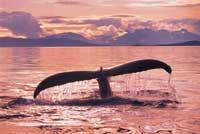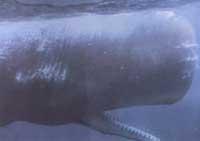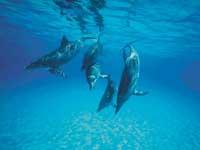Noise, an invisible threat of marine mammals
2001/04/08 Carton Virto, Eider - Elhuyar Zientzia
About 50 million years ago, the ancestors of modern whales and dolphins made the way from land to water, but once they evolved from that medium, they were not willing to live in the water. Under the water the sight does not stop much and the smell had not developed it enough to be useful. The auditory discovery of the key to survival and the inability to see it in the water were replaced by the adaptation of the hearing system.

The ears adapted to the subaquatic physical conditions and, at present, are able to capture and produce sounds inaudible to the human being. It is hardly known how and for what whales and dolphins use sounds, but the data collected suggest that they can play an important role in the life cycle. For example, mothers and
children use them to stay together, for adults to call the couple or to avoid risk during migration and to get away from the coast. Some species of whales are known to hear when carnivorous orcas approach. Although concrete data are scarce, biologists believe that the first sense of marine mammals is the ear. For humans hearing can be seen.
Low or low frequency sounds can travel further, so it is no wonder that whales and other marine mammals communicate through sounds below 1,000 hertz. The blue whale, the largest animal in the world, for example, produces extremely low infrasonids, and the normal, on the other hand, emits sounds so constant that they are at the threshold of the human ear, that divers have considered for years as the carrasca of the marine soil. The best known are the songs of the Xibarta whales looking for females. They seem to be formed like bird songs and with them it is believed that the male realizes his gifts. Without a doubt, whale songs are the lowest and at the same time the most spectacular, but dolphins, seals, walruses and manatees also "speak" in the same register.

Unfortunately, they are not the only sounds that can be heard at sea. The human being has had an undeniable tendency to the sea and fishing boats, to conquer new territories or to transport goods have crossed the seas and oceans side by side. Formerly they were not so noisy, but since the industrial revolution the world's seas have been occupied by an industrial buzz.
The hum of the apparatus and engines of the ships, the compressed air explosives launched in search of oil, low-frequency signals sound, is not peaceful at sea. From Vladivostok to Panama you can hear the sound of human activity anywhere. For example, according to a study conducted in California, between 1950 and 1975 environmental noise has increased by 10 decibels.
Adverse effects
It cannot be said, but it seems that the noise produced by human activity in the seas is detrimental to native animals, especially because many of the sounds produced by humans under the sea come from the same frequency band that animals use to communicate.

The biologist and human participation have only begun to investigate the marine animals' use of sound, so they barely know anything about the damage they can cause. However, they suggest that some of the most suspicious facts may be true. Last March, for example, biologists investigating whales in the Bahamas detected strange behaviors. In a few days, 16 whales landed and 8 died in an arc of 100 kilometers. It was soon suspected that something strange was happening, as whales barely land a year.
In order to clarify the causes of these deaths, skeleton and tissue samples were collected from dead whales, and although research has not yet concluded, the noise hypothesis is the most powerful. It seems that in studies on ears and tissues there have been found traces of bleeding to the landed whales. These hemorrhages are the same as those caused by the pressure of sound waves, so it is believed that whales were attenuated and mixed by noise. It is not possible to demonstrate a direct cause-effect relationship, but the American army was rehearsing in that region with an anti-aquatic sonar. Is it chance?
Since 1970, extraordinary whale landings near military exercise zones have been observed on three occasions, but physical evidence demonstrating the relationship between the two phenomena has never been obtained. It now seems that from the samples collected in the Bahamas last March more information can be obtained than ever, and even if there are no immediate revolutionary laws on sea noise, at least you can learn better about how noise affects marine animals.
Qualitative model

Without losing sight of data scarcity and limitation, biologists have developed a qualitative model of biological impact of noise. As a rule, it can be said that the influence of any sound will depend on the distance between the origin of the sound and the animal. In general, the nature and severity of the damage will depend on the distance.
Obviously, the most serious damage will occur near the origin. The impact is direct and expansive: serious physiological damage and, at worst, the death of the animal. As in humans, very intense sounds can damage the tissues and ears of marine mammals and cause deafness or hearing loss. Thus, and given that they are essential for auditory communication, the behavior of animals will necessarily be modified. For example, they may be isolated and die. Therefore, although the sound does not die directly, its side effects do. As they move away from the source, the nature and severity of the damage changes and may result in hearing loss and short-term or long-term behavioral changes.
Main sources of noise in the seas
The main source of ocean noise is transport. For example, a giant tanker traveling 20 miles per hour saturates the frequency band of less than 500 hertz with a noise equal to or greater than 190 decibels, while the ferry sized ships sound between 160-170 decibels.
The noise generated together by the transatlantic, oil, icebreaker and other ships is only overcome by some strong storm or earthquake and is continuous, both in time and intensity. Among other sources, the equipment used by the oil industry is especially noisy, mainly drilling equipment and explosives.

Most oil companies use compressed air explosives to detect oil in ocean bottoms. The explosives are transported in a row behind a small container and explode frequently fixed. The explosion is so strong, in which the waves reach the rocks located hundreds of meters under the water, and interpreting them, you can know if there is oil below. If there is oil, of course, the platform will be placed with the noise generated by its construction and operation. Ideal for oil companies but for marine animals.
On the other hand, in recent decades human beings have generated two other important sources of noise: active sonars and acoustic thermometers. The latter calculates the water temperature in the time it takes the sound to travel underwater and is a very useful tool for scientific research. But it uses low-frequency sound pulses, so it is very possible to influence the life of mammals. Active sonars are mainly used by the military, who also use low-frequency pulses.
Published in the supplement Natura de Gara

Gai honi buruzko eduki gehiago
Elhuyarrek garatutako teknologia





